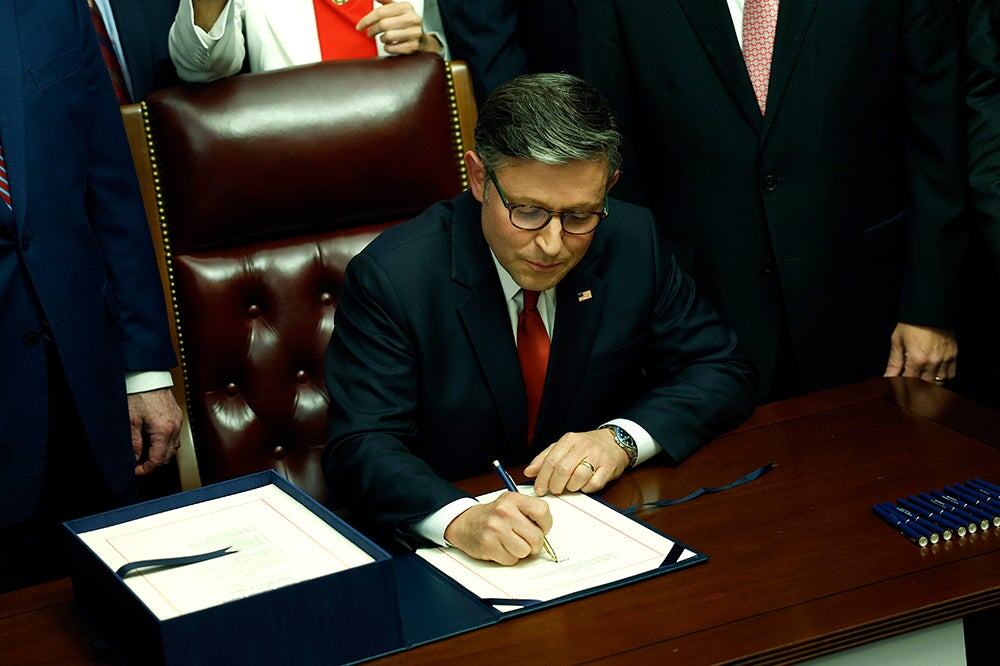Health Care Bill: Coverage Gain, Fiscal Pain
NEW YORK (September 9, 2009) — A mixed picture emerges from a new study commissioned by the Peter G. Peterson Foundation on America’s Affordable Health Choices Act of 2009 (H.R. 3200). The study, conducted by The Lewin Group, provides a critical look at longer-term cost implications of a major comprehensive health care reform proposal, estimating the impacts through the year 2029, making it the first analysis of health care reform costs beyond 2019. The study examines the House legislation as amended by the Energy and Commerce Committee. The Foundation plans to commission similar analyses of other major reform proposals, including the one from the Senate Finance committee, as legislation is introduced.
| Spending,Changes | 2010-2019 | 2020-2029 | 2010-2029 |
|---|---|---|---|
| Medicaid Eligibility Expansion |
375 | 1,086 | 1,461 |
| Premium Subsidies Employer pay or play payroll taxes |
667 -291 |
2,228 -693 |
2,895 -984 |
| Public Plan Start-up Retiree Reinsurance Program |
2 10 |
0 0 |
2 10 |
| Medicare and Medicaid Payment Reforms |
-231 | -735 | -966 |
| Changes in Other Federal Programs |
-3 | -8 | -12 |
| Total changes to spending |
530 | 1,877 | 2,407 |
| Revenue Changes |
2010-2019 | 2020-2029 | 2010-2029 |
| Taxes on High Income |
588 | 1,148 | 1,735 |
| Employer Tax Credit Penalties for Uninsured |
-64 67 |
-165 135 |
-228 2020 |
| Taxes on Changes in Wages |
-100 | -250 | -350 |
| Total Changes to revenue |
491 | 868 | 1,359 |
| Total impact on federal deficit |
39 | 1,010 | 1,048 |
“This nation needs to engage in comprehensive health care reform that will include some level of universal coverage. At the same time, this study shows that the top priority needs to be reducing total health care costs and the rate of increase in future costs. For health care reform to be fiscally sustainable, it must not just pay for itself over 10 years and beyond, it should also result in a significant reduction in the tens of trillions of dollars in the federal government’s unfunded health care promises,” said David M. Walker, President and CEO of the Foundation.
The study indicates that America’s Affordable Health Choices Act of 2009, as amended by the Energy and Commerce Committee, would expand health insurance coverage, but it would also increase the nation’s total health spending. Although the Act would nearly pay for the expanded coverage in the first 10 years as new provisions are put into place, over time, the sources of financing do not keep pace with the expected growth in new costs.
Key findings include:
- The net federal cost of the Act over the 2010 through 2019 period would be $39 billion (excluding debt service costs) and, thus the Act would be nearly fully funded as reforms phase in during the first ten years. The net federal cost of the Act over the following ten years (2020 through 2029) would be $1.01 trillion (excluding debt service costs) due to rapid growth in health care costs that will outpace the growth in incomes and revenues over the longer-term.
- The study estimates that under the Act (assuming full implementation and mature enrollment) almost 30 million people would gain insurance coverage in 2011, a reduction of 60 percent in the ranks of the uninsured.
- 41 million people would obtain health insurance through newly-created health insurance exchanges, including 21 million in the public plan. Enrollment in the Medicaid program would grow by 10 million.
- Families in which all members currently have insurance would save an average of about $176 under the Act, while families with one or more uninsured members would, on average, see an increase in family health spending of $1,410 per family.
- Overall, employer health spending would increase by an average of $305 per worker. Employers that currently offer insurance would see an increase in health spending of $123 per worker, while employers that do not now offer coverage would see an increase in health spending by an average of about $813 per worker. (However, most economists believe that employers would eventually offset the increased costs through slower wage growth. As a result, families and individuals would ultimately bear the increases in costs, which is reflected in the bullet above..) Small businesses currently providing insurance would save up to an average of $811 per worker due to a tax credit.
- The number of people covered in employer-sponsored plans (outside of the health insurance exchanges) would fall by 11 million, and overall enrollment in private plans would decline by about 900,000.
- The Act would result in a net savings to state and local governments of about $62.6 billion over the 2010 through 2019 period, primarily due to savings in safety-net programs that currently serve the uninsured. States would save about$125.7 billion over the 2020 through 2029 period.
Further Reading
Quiz: How Much Do You Know About Healthcare in the United States?
The United States has one of the largest and most complex healthcare systems in the world. Take our healthcare quiz to see how much you know about the cost and quality of the U.S. healthcare system.
The Fed Reduced the Short-Term Rate Again, but Interest Costs Remain High
High interest rates on U.S. Treasury securities increase the federal government’s borrowing costs.
How Did the One Big Beautiful Bill Act Change Tax Policy?
See how OBBBA restructured the tax landscape across four major areas: individual tax provisions, business tax provisions, energy tax credits, and health-related tax changes.


